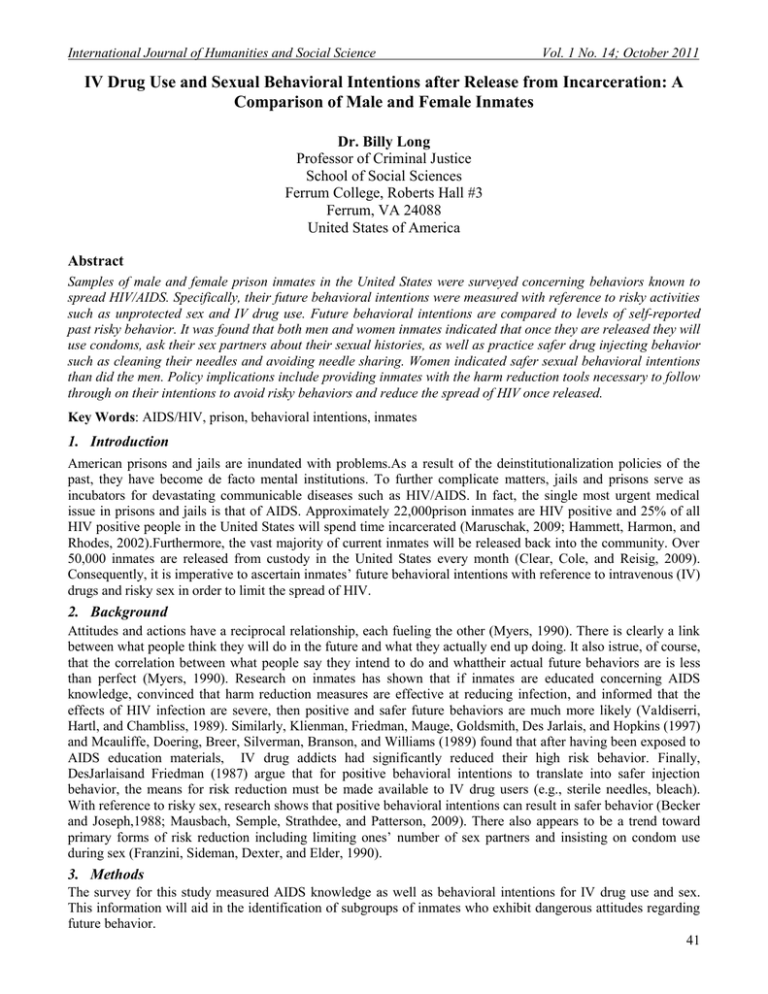
International Journal of Humanities and Social Science
Vol. 1 No. 14; October 2011
IV Drug Use and Sexual Behavioral Intentions after Release from Incarceration: A
Comparison of Male and Female Inmates
Dr. Billy Long
Professor of Criminal Justice
School of Social Sciences
Ferrum College, Roberts Hall #3
Ferrum, VA 24088
United States of America
Abstract
Samples of male and female prison inmates in the United States were surveyed concerning behaviors known to
spread HIV/AIDS. Specifically, their future behavioral intentions were measured with reference to risky activities
such as unprotected sex and IV drug use. Future behavioral intentions are compared to levels of self-reported
past risky behavior. It was found that both men and women inmates indicated that once they are released they will
use condoms, ask their sex partners about their sexual histories, as well as practice safer drug injecting behavior
such as cleaning their needles and avoiding needle sharing. Women indicated safer sexual behavioral intentions
than did the men. Policy implications include providing inmates with the harm reduction tools necessary to follow
through on their intentions to avoid risky behaviors and reduce the spread of HIV once released.
Key Words: AIDS/HIV, prison, behavioral intentions, inmates
1. Introduction
American prisons and jails are inundated with problems.As a result of the deinstitutionalization policies of the
past, they have become de facto mental institutions. To further complicate matters, jails and prisons serve as
incubators for devastating communicable diseases such as HIV/AIDS. In fact, the single most urgent medical
issue in prisons and jails is that of AIDS. Approximately 22,000prison inmates are HIV positive and 25% of all
HIV positive people in the United States will spend time incarcerated (Maruschak, 2009; Hammett, Harmon, and
Rhodes, 2002).Furthermore, the vast majority of current inmates will be released back into the community. Over
50,000 inmates are released from custody in the United States every month (Clear, Cole, and Reisig, 2009).
Consequently, it is imperative to ascertain inmates’ future behavioral intentions with reference to intravenous (IV)
drugs and risky sex in order to limit the spread of HIV.
2. Background
Attitudes and actions have a reciprocal relationship, each fueling the other (Myers, 1990). There is clearly a link
between what people think they will do in the future and what they actually end up doing. It also istrue, of course,
that the correlation between what people say they intend to do and whattheir actual future behaviors are is less
than perfect (Myers, 1990). Research on inmates has shown that if inmates are educated concerning AIDS
knowledge, convinced that harm reduction measures are effective at reducing infection, and informed that the
effects of HIV infection are severe, then positive and safer future behaviors are much more likely (Valdiserri,
Hartl, and Chambliss, 1989). Similarly, Klienman, Friedman, Mauge, Goldsmith, Des Jarlais, and Hopkins (1997)
and Mcauliffe, Doering, Breer, Silverman, Branson, and Williams (1989) found that after having been exposed to
AIDS education materials, IV drug addicts had significantly reduced their high risk behavior. Finally,
DesJarlaisand Friedman (1987) argue that for positive behavioral intentions to translate into safer injection
behavior, the means for risk reduction must be made available to IV drug users (e.g., sterile needles, bleach).
With reference to risky sex, research shows that positive behavioral intentions can result in safer behavior (Becker
and Joseph,1988; Mausbach, Semple, Strathdee, and Patterson, 2009). There also appears to be a trend toward
primary forms of risk reduction including limiting ones’ number of sex partners and insisting on condom use
during sex (Franzini, Sideman, Dexter, and Elder, 1990).
3. Methods
The survey for this study measured AIDS knowledge as well as behavioral intentions for IV drug use and sex.
This information will aid in the identification of subgroups of inmates who exhibit dangerous attitudes regarding
future behavior.
41
© Centre for Promoting Ideas, USA
www.ijhssnet.com
If inmates do not indicate a willingness to alter risky behavior, AIDS education programs can be modified to
address these groups specifically. As a way of collecting baseline data, inmates were asked to indicate their IV
drug use and sexual behaviors before being incarcerated. Thus, this approach represents an approximation of a
longitudinal design whereby cross sectional data collected at one point in time can be used to create an estimate of
changes over time (Babbie 2010). Two hundred ninety-eight male and 155 female inmates were sampled from
three prisons in a northeastern state known to have very high rates of HIV when compared to prisons across the
nation. Table 1 summarizes past IV drug use and sexual behavior:
Insert Table 1 about here
Greater proportions of the women indicated past participation in behaviors that increase their risk for HIV
infection, especially drug-related behaviors. Seventy-four (25%) of the men and 65 (42%) of the women indicated
past IV drug use on the street, while 20 (7%) of the men and 10 (7%) of the women admit to continuing their use
in prison. Forty-nine (16%) of the men and 51 (33%) of the women also admitted to having shared injection
equipment at some time in their pasts. On the sexual question, women seem to have a history of safer behavior; a
higher proportion of the women reported discussing HIV with past partners. This still suggests room for
improvement in promoting safer sexual behaviors.
Three questions were included to measure behavioral risk using a continuum from low (zero = never) to high (10
= always). Table 2 suggests that of those inmates who admitted to injecting drugs in the past, men and women
reported similar levels of cleaning their needles. Subjects also were asked about frequency of condom use in the
past and frequency of questioning sex partners about their sexual histories.
Insert Table 2 about here
Women indicated higher average levels of condom use and of questioning sex partners. Women used condoms
and questioned their sex partners more often than the men, but still fairly infrequently. Out of a possible score of
10, women scored a 3.39 for condom use and a 4.97 on discussing the history of their sex partners.Men scored
2.59 and 3.55 respectively; thus women scores indicate safer behavior on both items. However, for both men and
women, the scores on both of these items suggest somewhat sporadic condom use and discussions with sex
partners. Finally, men and women who had injected drugs indicated a willingness to use bleach to clean their
needles but both groups did this only about half the time. These findings serve as baseline data with which to
compare future behavioral intentions.
3.1 Behavioral Intentions
Six questions were asked of respondents to assess what their behaviors might be like after they are released from
prison. Three items were included pertaining to future drug-related behaviors: 1) use of IV drugs; 2) sharing
equipment; and 3) if they thought they would use IV drugs, whether they would use bleach or alcohol to clean
their needles. These three items were combined into an index called “IVDU behavioral intentions.” The other
three items pertaining to future sexual behavior include: 1) condom use; 2) asking partners about their sexual
histories; and 3) discussing AIDS with sex partners. These were combined into an index called “sexual
behavioral intentions.”
The six items were measured on a continuum from low (zero = definitely will) to high (10 = definitely will not).
On the drug-related items, lower scores indicated intentions to engage in more risky behaviors. On the sex-related
items, lower scores indicated intentions to engage in safer behaviors.
Table 3 details the inmates’ responses on these indexes. Women reported that they intended to be safer than men
with respect to sexual behaviors. However, they appeared to be about the same as the men with respect to IV drug
use intentions.
Insert Table 3 about here
It was possible that the men and women differed on individual items within the indexes, but those differences
were masked when looking at the overall index means. To determine whether this happened, two ANOVAS were
done on all items within both indexes by sex to determine how the overall mean was formed. For example, it was
possible for men and women to have identical means on the IV drug use index (the combination of three
variables) while differing only on one dimension of this variable . The resulting ANOVA yielded no significant
differences on the three items by sex and when the three were combined, the means were not significantly
different.
42
International Journal of Humanities and Social Science
Vol. 1 No. 14; October 2011
This reinforces the indexed-based finding that men and women are very similar in terms of their future behavioral
intentions regarding IV drug use. For the index of sex-related behaviors, the ANOVA indicated significant
differences for all the dimensions of making up this variable. That is, females indicated significantly safer
behavior on all separate index items as well as on the grand mean itself. This means that any difference between
men and women on the sexual behavioral intentions index cannot be attributed to a large difference on only one of
the three index items. In other words, the statistically significant difference between men and women was found
because the groups differed on all the items; women clearly intend to be safer in all areas of sex included in the
index.
3.2
IV Drug Use Behavioral Intentions Hypothesis Test
The IV drug use behavioral intentions index was formed from three variables. On this index, a high score (nearer
10) reflected a willingness to engage in safer behavior, and a low score (nearer zero) reflected a more risky
outlook . As Table 3 illustrates, men and women indicated a similar likelihood of engaging in more risky
behaviors upon release. A two-tailed T-test conducted on this index for both gender groups showed no significant
difference at the 0.05 level. However, while women indicate relatively safe future behavioral intentions with
reference to IV drug use, it is important to note that they have much riskier pasts. As noted above, women were
much more likely to have engaged in IV drug use on the street and to have shared works on the street. Therefore,
the women may be overly optimistic about what they might do in the future. At any rate, it is very bold to
conclude that women will definitely follow through on their behavioral intentions.
3.3
Sexual Behavioral Inventions Hypothesis Test
The sexual behavioral intentions index was formed from three variables designed to assess the future intentions of
respondents in terms of their sexual behavior. The index was constructed so that a lower score, or mean, indicated
safer intentions, with a higher score indicating more risky intentions. To evaluate the difference between males
and females on this index, a T-test was conducted. TheT-test indicated a statistically significant difference (P =
.000) between the mean for the men (3.1) and for the women (1.9). Men indicated intentions to engage in more
risky sexual behaviors upon release than did females. However, the proportional reduction in error (PRE) measure
used (ETA square = 0.04) suggests that only about 4% of the variation in sexual behavioral intentions could be
explained by sex. While the T-test suggests a non-zero difference between men and women, sexually-related
behavioral intentions cannot be predicted very accurately from knowing ones’ gender (the independent variable)
with much efficiency.
The results of this analysis mean that, in general, men and women expressed intentions to engage in safer
practices in both areas. Both sexes have means on IV drug use behavioral intentions (8.5 for men and 8.454
women) and sexual behavior intentions (3.12 for men and 1.89 for women) that suggest they at least intend to be
safer once released from prison. The only significant differences in the area of sexual behavioral intentions were
women intend to be slightly safer than men. The obvious policy implication of this is to provide inmates with the
necessary tools and training to follow through on these intentions. This should include HIV prevention kits upon
release that include clean needles, bleach, condoms, anddental dams for both groups; in addition, women must be
taught how to be more assertive in the area of sexual negotiation (i.e., encouraging condom use for their sex
partners). Discharge planning by departments of correction also could help inmates follow through on their
intentions.
Inmates must be convinced that they are capable of implementing strategies that will reduce their risk of infection
for a behavioral change to take place. Correctional officials must acknowledge the fact that many inmates are
from extremely deprived backgrounds and use IV drugs as a means of coping. Therefore, it seems inappropriate
for prisons to force inmates into accepting a dichotomy: IV drug use on the outside and complete abstinence on
the inside. Harm reduction theory takes the inmate at whatever point they are in their lives and stresses how the
individual can become safer, but only in an incremental fashion (Harm Reduction Coalition, 2011). Once
standard AIDS information is disseminated showing how the inmate puts him/herself at risk and tools are made
available to help the users continue their drug using practice, but with less risk of infection, techniques need to be
employed to help the user understand that this approach is effective at HIV prevention. Success stories should be
highlighted to the user including peer educators who have been successful at IV drug use reduction (Collica,
2007). Ultimately, this would help at-risk offenders to follow through on positive behavioral intentions after being
released from incarceration.
43
© Centre for Promoting Ideas, USA
www.ijhssnet.com
REFERENCES
Babbie, E. (2010). The practice of social research (12th Ed.). Belmont, CA.: Wadsworth.
Becker, M. and Joseph, J. (1988). AIDS and behavioral change to reduce risk: A review. American Journal of Public
Health, 78, 394-410.
Clear, T., Cole, G., and Reisig, M. (2009). American Corrections (8th Ed.). Belmont, CA:
Wadsworth.
Collica, K. (2007). The prevalence of HIV peer programming in American prisons: An opportunity wasted. Journal
of Correctional Health Care, 13, 278-288.
Des Jarlais, D. and Friedman, S. (1988). The psychology of preventing AIDS among IV drug users. American
Psychologist, 43, 865-870.
Franzini, L., Sideman, M., Dexter, K., and Elder, J. (1990). Promoting AIDS risk reduction via behavioral training.
AIDS Education and Prevention, 2, 313-321.
Hammett, T., Harmon P., and Rhodes, W. (2002).The burden of infectious disease among inmates and releasees from
correctional facilities. In The health status of soon-to-be released inmates: A report to Congress. Vol. 2.
Chicago: National Commission on Correctional Health Care.
Harm Reduction Coalition (2011).Principles of harm reduction.[Online].Available
http://harmreduction.org/section.php?id=62, 17 Aug 2011.
Klienman, P., Friedman, S., Mauge, C., Goldsmith, D., Des Jarlais, D., and Hopkins, W. (1987).Beliefs and behaviors
regarding AIDS: A survey of street IV drug users. Paper presented at the 3rd International Conference on AIDS,
Washington, DC.
Maruschak, L. (2009). HIV in prisons, 2007-2008.Bureau of Justice Statistics: Bulletin. [Online].Available
http://bjs.ojp.usdoj.gov/index.cfm?ty=pbdetail&iid=1747, 17 Aug 2011.
Mausbach, B., Semple, S., Strathdee, S. and Patterson, T. (2009).Predictors of safer sex intentions and protected sex
among heterosexual HIV-negative methamphetamineusers: An expanded model of the theory of planned
behavior.AIDS Care,21, 17–24.
Mcauliffe, W., Doering, S., Breer, P., Silverman, H., Branson, B. and Williams, K. (1989).AIDS, sexual behavior, and
IV drug use. Washington, DC: Commission on Behavioral and Social Sciences and Education
Myers, D. (1990). Social psychology (3rd Ed.). NY: McGraw-Hill.
Valdiserri, E., Hartl, A., and Chambliss, C. (1988). Practices reported by incarcerated drug abusers to risk of AIDS.
Hospital and Community Psychiatry, 39, 966-972.
TABLES
TABLE 1: Sample Comparisons of Frequencies of Self-Reported Drug Use and of Discussing AIDS with
Sex Partners
Used IV drugs on the street
Males
N = 298
25%
Females
N = 155
42%
Used IV drugs in prison
7%
7%
Shared works on the street
16%
33%
Discussed AIDS with sex partners
63%
70%
% indicates yes responses
44
International Journal of Humanities and Social Science
Vol. 1 No. 14; October 2011
Table 2: Comparison of Mean Levels of Cleaning Needles, Using Condoms, and Discussing
Sex Partners' Sexual Histories Between Men and Women
Variable
Group
N
Mean
Frequency of using
bleach to clean needles
Men
Women
73*
65*
4.9
4.5
Frequency of condom
use during sex
Men
Women
297
137
2.59
3.39
Discussed history
of sex partner
Men
Women
295
148
3.55
4.97
*N Refers to the number of respondents answering the question:
This item had a smaller N because many inmates had never used by IV drugs
Table 3: Comparison of Men and Women for IV Drug Use and Sexual Behavioral Intentions
Variable
Group
N
Mean
IV drug use
Behavioral
intentions
Men
Women
295
148
8.5
8.45
0 = risky
10 = safe
295
148
3.12
1.89
0 = safe
10 = risky
(T = -.47, p. = .319, not significant)
Sexual
Behavioral
Intentions
Men
Women
T = 4.19, p = .000* (ETA Square= .04)
* Significant Two-Tailed <.05
45






